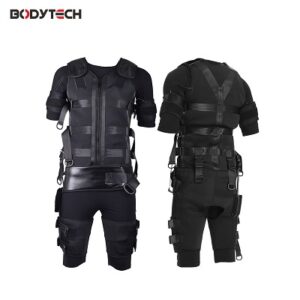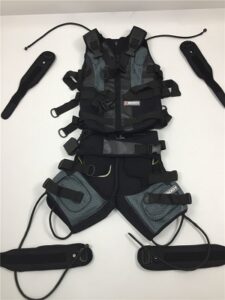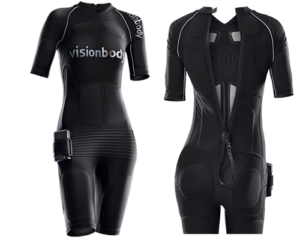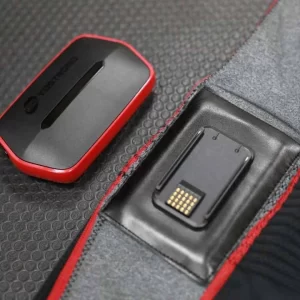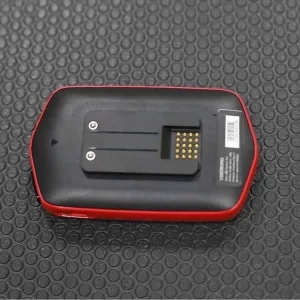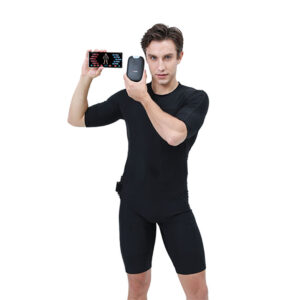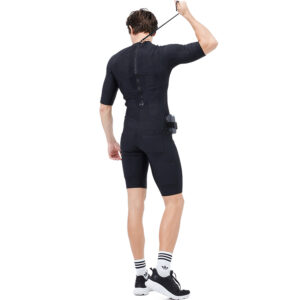In the ever-evolving landscape of fitness and exercise, groundbreaking innovations continuously reshape our approach to physical well-being. One innovation that has captivated widespread attention is the EMS suit—short for Electrical Muscle Stimulation.
Also referred to as neuromuscular electrical stimulation (NMES), this technology has revolutionized the path to achieving fitness aspirations. By harnessing precisely controlled electrical impulses to activate muscles and prompt muscle contractions, the EMS suit offers an unparalleled workout experience. This innovation unfolds the potential for elevated muscle growth, heightened performance, and expedited recovery, all within the comfort and convenience of your own home.
Decoding Electrical Muscle Stimulation
At its core, EMS involves the application of electrical impulses that directly stimulate motor neurons, triggering muscle contractions. Unlike traditional workouts, where your brain sends signals to your muscles to contract voluntarily, EMS bypasses this process by inducing involuntary contractions. The EMS unit, which can come in various brands like Powerdot, Compex, Tone-A-Matic, or MarcPro, is the conduit for delivering these electrical impulses. This process is conducted through sticky, rubbery pads placed on the skin at specific muscle points.
The beauty of EMS lies in its ability to create diverse muscle contractions, ranging from quick and frequent to sustained contractions held for uncomfortable seconds or even minutes. This unique feature makes it an intriguing addition to the fitness landscape.
The Science Behind the Stimulation
How effective is EMS, and does it truly deliver on its promises? Science offers some compelling answers. A study published in the Journal of Strength and Conditioning explored whether elite athletes could gain a performance edge through EMS. Surprisingly, the analysis concluded that even trained and elite athletes, already possessing a high level of fitness, experienced significant improvements in strength comparable to untrained subjects.
Furthermore, EMS suit has demonstrated versatility in areas beyond fitness, from pain management to increasing muscle blood flow for warming up before performance-related activities.
Tailoring Your EMS Fitness Journey
The versatility of EMS translates into various ways it can be integrated into your fitness regimen:
1. Warm-up and Potentiation
EMS can increase blood flow and raise muscle temperature, enhancing their effectiveness during workouts. It can also be combined with isometric exercises to improve tolerance to lactate build-up during intense activities.
2. Strength and Endurance
EMS can enhance strength, resistance, and endurance training by targeting different muscle fiber types through varying frequencies. It stimulates specific muscle fibers responsible for delivering energy aerobically and anaerobically.
3. Recovery and Massage
EMS aids in muscle recovery by increasing blood flow, reducing soreness, and promoting relaxation. The pulsating currents create a massage-like effect, enhancing overall recovery.
4. Exercise Combination
EMS can be integrated with conventional exercises, such as weight training and cardiovascular activities. By amplifying muscle engagement, EMS can elevate the effectiveness of your workouts.
Maximizing Effectiveness and Safety
As with any fitness method, proper usage and safety precautions are crucial. Here are some tips to consider:
- Train muscle groups thrice a week, allowing 48 to 72 hours of recovery between sessions.
- Seek guidance from fitness professionals experienced in EMS to ensure correct usage and programming.
- Listen to your body’s signals during EMS sessions. Adjust intensity and duration based on comfort and response.
Conclusion
In a world where technology constantly reshapes our understanding of fitness, Electrical Muscle Stimulation (EMS) emerges as a remarkable innovation that bridges tradition with progress. The ability to stimulate muscles through controlled electrical impulses opens doors to enhanced muscle activation, improved strength, and accelerated recovery.
While EMS isn’t a magic solution that replaces conventional exercise, it amplifies the potential of your fitness journey. By weaving EMS into your regimen and adhering to safety measures, you can unlock new dimensions of physical achievement and redefine your fitness potential.
Q1: Can EMS help with muscle recovery?
Yes, EMS can aid in muscle recovery by increasing blood flow and reducing soreness. Recovery-focused EMS programs offer massage-like effects to alleviate muscle tension.
Q2: Are there any medical conditions that might make EMS unsuitable?
Individuals with certain medical conditions, such as heart conditions, epilepsy, or pregnancy, should consult a medical professional before using EMS.
Q3: Can EMS lead to muscle growth and fat loss simultaneously?
A: While EMS can enhance muscle activation and potentially contribute to fat loss, a holistic approach involving proper nutrition and consistent exercise is necessary for significant results.
Q4: Is EMS a replacement for cardiovascular exercise?
A: EMS can complement cardiovascular exercise, but it’s not a complete replacement. Combining EMS with traditional cardio workouts can lead to a well-rounded fitness routine.
Q5: How often should I use EMS for optimal results?
A: Using EMS three times a week with adequate recovery time between sessions is generally recommended. Consultation with fitness professionals can help tailor a suitable plan.


